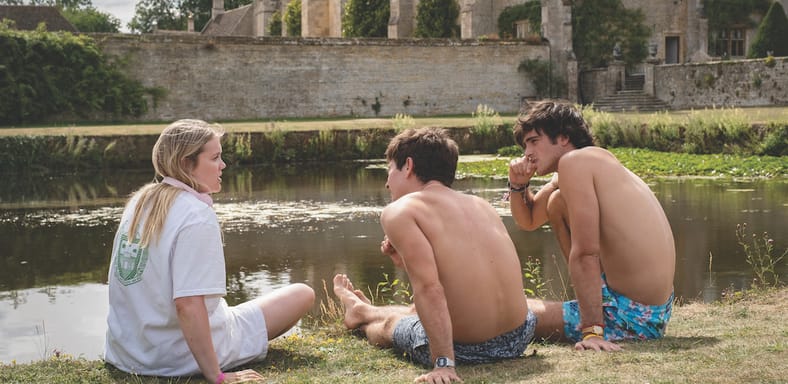
“There is a place in England called Saltburn, which is by the sea,” says Emerald Fennell. “And it’s very beautiful. These towns tend to be named after houses, and they tend to not be very close to each other. And I think I must have been to Saltburn when I was younger and it always just struck me as such an evocative place name — and also sexy.”
She adds: “There’s just something about the idea of salt burn, which I think, even if you don’t know what it is, if you don’t know it’s a place, it has the kind of pleasure-pain feeling of a kind of post-coital sweat burn that is kind of thrilling. And it was just always called that.”
The Oscar winner is explaining how her new film Saltburn — the follow-up to her breathtaking 2020 feature debut, Promising Young Woman — got its title. Her answer includes a tapestry of hints about what the film portrays: beauty; being so enamored of a distant spectacle that you give yourself its name; getting burned.
Saltburn draws on Fennell’s own experiences at Oxford to tell the story of a scholarship boy named Oliver Quick (Barry Keoghan) who develops an obsession with a popular and affluent classmate named Felix Catton (Jacob Elordi). Felix invites Oliver to stay with his family at their castle, Saltburn, where he summers with a cavalcade of characters including Felix’s parents and sister — played by Richard E. Grant, Rosamund Pike and Alison Oliver — and two curious additions played by Carey Mulligan and Archie Madekwe. It’s set around 2007, when Bloc Party ballads hover in the air, just before the ubiquity of phones and texts, when you could still enjoy a karaoke night in your castle in peace.
Because it’s an Emerald Fennell movie, it’s filled with twists and transgressions and dirty fun and looks utterly gorgeous even when things are going terribly for the people on screen. Everything is meticulously, deliciously crafted.
“It’s about want,” says Fennell, speaking via Zoom, sitting on the cold floor of a pristine room in the United Kingdom. “I just think we are living in a time now of so much complicated desire. The extremities of everything now means that it’s just a feast, to the point of throwing up, or total famine. Exploring that desire felt important.”
Also: There is no real castle called Saltburn. It is unattainable, except on film.
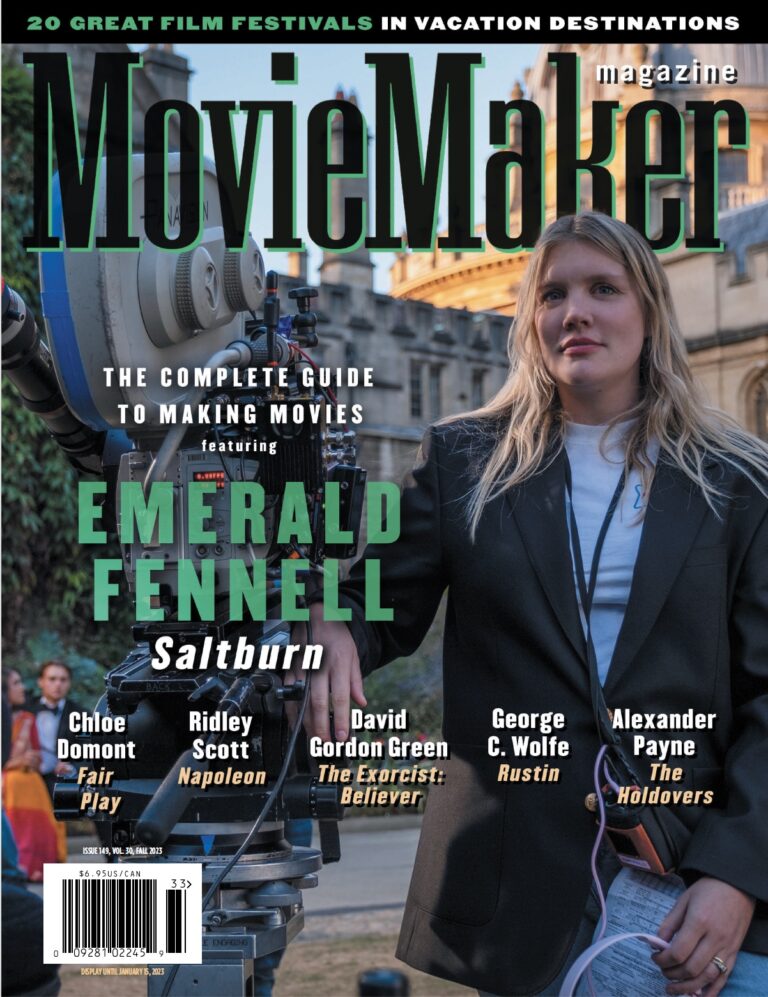
A Leaky Bucket
What has Fennell always wanted?
“It’s a really interesting question. I actually don’t know,” she says. “When it comes to the movie, I tend to be in the character or in the room, so I don’t know how much I’m aware of bringing my own stuff. I mean, I’m sort of thinking as Oliver, or as Felix,” she says.
“As far as what my kind of driving desire is — for somebody who’s just made a film about it, I actually think that’s what’s so scary: I don’t know that any of us necessarily even know. I don’t know that I know. I mean, certainly, making things is a kind of relentless drive. I feel very lucky. I only feel sane, really, when I’m doing it.
“But of course there are lots of parts of me that want all of the things that we all want, that are kind of seedy and pathetic,” she adds. “I want all — you know — I think all of it.”
She notes that comedian Reece Shearsmith, who plays a tutor in Saltburn, once likened his ambitions to “a leaky bucket.” She relates. Maybe everyone does.
“You name it: Food, clothes, stuff, people,” she says. “It’s all a leaky bucket.”

Oxford
Given that she went to Oxford at the same time as her fictional characters, does she relate more to Oliver, or to Felix? She came from a wealthy family, like Felix. But her family aren’t titled nobility, like his. They don’t live in a castle. (“Not yet!” she smiles.)
So did she sympathize more with the insider? Or the outsider? Is it reductive to even ask?
“I don’t ever have sympathies,” she explains. “Or rather — I only have sympathy.”
Oxford was important to Fennell’s career because it was there that an agent saw her in a play, and helped her become a professional actor. Soon she was landing roles on British shows like Trial & Retribution, where she met Mulligan, who she would later cast in the lead of Promising Young Woman.
“Emerald played ‘Bitchy Girl in Nightclub’ and I played ‘Girl Who Gets Murdered,’” Mulligan told MovieMaker in 2020. “We had a fight in the nightclub, and then I got thrown down the stairs. Not by Emerald.”
Fennell’s acting career has included prominent roles on Call the Midwife, then The Crown, where she plays the young Camilla Parker Bowles. She also turned up in Barbie as Midge, Barbie’s pregnant friend. LuckyChap, the production company of which Margot Robbie is a founder, has produced both of Fennell’s features.
Even as she earned bigger roles, Fennell wrote novels throughout her acting career: 2012’s Shiverton Hall, about a very spooky school; the 2014 sequel The Creeper, and 2015’s Monsters, about 12-year-olds dealing with a murder in a small seaside town.
Jessica Knappett, creator of the British sitcom Drifters, read Monsters and invited Fennell to work on her show. From there Fennell directed her first short film, “Careful How You Go,” and became the showrunner of the second season of Killing Eve.
If it seems like a straight line, it isn’t.
“The way I came at it was from lots of different directions,” Fennell says. “It was just trying, making anything that I could. My first book was published because I’d written a script and nobody wanted to make a script, obviously, by a 23-year old who’d written a mad, unmakeable, expensive, sort of Gothic boarding school horror story for children. Children’s horror isn’t an enormously popular genre.”
But after a meeting with a publishing house, she saw how she could turn some of the ideas into Shiverton Hall.
Even before Oxford, Fennell had spent her youth acting, writing and directing. When she was a teenager, she directed a 15-minute, all-female version of David Mamet’s Pulitzer-winning play Glengarry Glen Ross that, she insists, “really wasn’t very good.”
“For me, writing and acting were always the same thing. Because I started — I’m sure loads of people start — with talking to myself, and having an imaginary world and having a parallel life. And it’s probably the thing that’s kept me sane, and that would have had me institutionalized if I lived 100 years ago.”

Emerald Fennell and Vision
The worlds of Saltburn and Promising Young Woman felt so real and vivid to her, she says, that she sometimes forgot not everyone on set could see them as clearly.
“Like when you say to the art department, ‘Oh no, I’m so sorry, I didn’t explain — the man operating the suckling pig, sorry, he’s dressed as a pig. And the pig is dressed like a man. Sorry, I wasn’t clear. And the pig needs false eyelashes and a little hat.”
Fennell estimates that she makes 200 decisions a day while making a film, about everything from the proscenium arch at a begrudgingly thrown party to the state of each character’s fingernails.
“It’s always, her nails are chipped and black. Or he has dirt under his thumbnail,” Fennell says. “Or he’s got one weird long pinky fingernail. No, her hair isn’t perfect — actually, she’s got a couple of months’ growout, because she’s not as rich as she used to be.”
“She’s an inventor of new imagery, truly,” says Linus Sandgren, Saltburn’s cinematographer. “She has cared for the smallest details, in what the characters do and how they do it, and which details she wants the camera to observe, and for how long. And this way, you will see scenes in Saltburn you haven’t seen before.”
Josey McNamara, one of the producers of Saltburn and Promising Young Woman for LuckyChap, says Fennell “leads with such a clarity of vision and articulation that she empowers people to self-manage and have ownership over their own roles.”
Part of that vision is pushing boundaries.
“Nothing ever feels ‘safe’ and her creativity lives right on the edge of failure, but that is what makes her voice so exciting,” he says. “She gives you permission to laugh at the most unexpected of moments and makes you question your own reactions.”
Promising Young Woman, for example, finds dark humor in a story of a woman – played by Mulligan — avenging a friend’s sexual assault. Her grim modus operandi includes pretending to be drunk so men will take her home, where she explains things they’d never considered about consent.
“Thinking back to our test screening of Promising Young Woman where we had audience members debating the correct response to a scene in real time and even a few walkouts, there was this sense of a shared emotional experience that couldn’t be denied,” McNamara says. “We talk a lot at LuckyChap about entertainment and interrogation in storytelling, and Emerald is the master at it. Her movies live with you long after you have left the theater.”
The experimentation worked: Fennell won the Oscar for best original screenplay, and was nominated for best director. Promising Young Woman’s other Oscar nominations were for best picture, best actress for Mulligan, and best editing for Frédéric Thoraval.
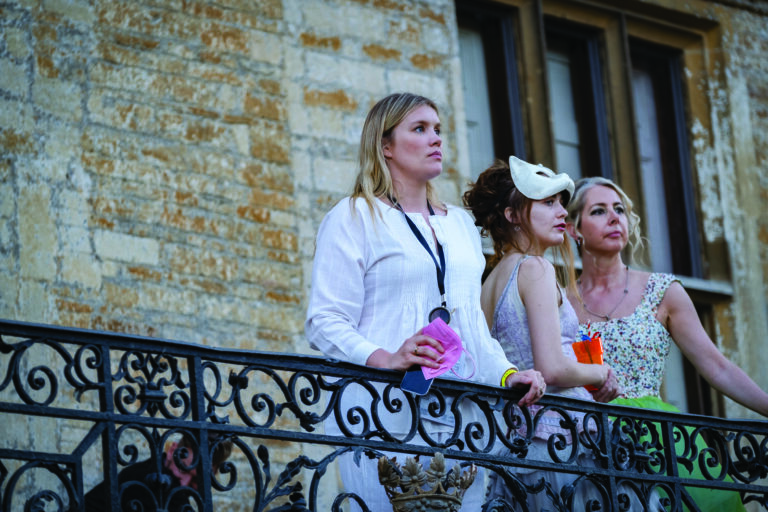
A Reasonably Gothic Sensibility
Fennell credits her parents with letting her pursue her artistic dreams — because they’d done the same.
Her father, Theo Fennell, grew up in an Army family, but eventually became such a successful jeweler, with clients ranging from Elton John to Joan Collins to Elizabeth Hurley to Madonna to Lady Gaga, that the British press call him the King of Bling, a nickname he doesn’t love.
Her mother, born Louise MacGregor, grew up on a farm in Wales, but became a novelist and screenwriter. Louise Fennell wrote a recent piece for the Daily Mail about her and Theo’s shabby-chic ’70s courtship, filled with big romantic gestures and unpaid bills.
At one point, she recalled, she tried to phone her parents to express doubts about the wedding (“We were penniless and too young and I still didn’t have a bloody dress to wear”) but couldn’t reach them because her phone was cut off.
The Fennells have been married for more than four decades. Their daughter can’t believe how fortunate she is to have been born to people who value creativity.
“It’s so important to talk about the difference it makes in your life when you’ve got parents who are supportive, who believe that anything like this is important. That’s huge,” she says. “And also having parents, frankly, who have worked as hard as my parents worked so that you can be an artist living in London, for the first five years… when you’re doing stuff for free, or you’re doing stuff for no money.”
They were also open-minded: “They were very, very relaxed about any TV, any movies, as long as it wasn’t like — I mean, I don’t know. I would definitely watch like Silence of the Lambs when I was seven or eight.”
She also drew from their “reasonably Gothic sensibility” and attention to craft — her father often works on details invisible to the naked eye, and she didn’t have to worry about offending anyone’s delicate sensibilities, given that her mother’s work, she laughs, is “much darker than mine.” She adds that her fashion designer sister, Coco, has “just always been kind of a genius.”
Saltburn’s Oliver is a craftsman. And despite his privilege, Felix is as well.
“I feel the desperation to fit in that Oliver feels — the thing of working, of overworking, of trying slightly too hard, of always doing too much. I completely understand the sadomasochistic relationship with things that you can’t have, whether it’s people or things or whatever. I think all of us, any person who’s ever been on Instagram, understands that,” she says.
“Felix is an interesting character, because like all of these people, he’s kind of a nice guy up to a point. He’s incredibly well-trained to put people at ease, and that’s something that I find very interesting… this kind of disarming quality. And that is a trap. Disarming — I suppose the word means taking someone’s power away.
“At first we fucking hate him. Oliver hates him. We all hate him. Who is this guy?” she says. “And then the moment you collide with them in real life, and it’s the same with movie stars, it’s the same in any, you know, charisma people. You think from afar, What a prick. And then you come close to them: Ohhhh, I see.”
She knows a lot of charisma people — those charmers with an astonishing ability to win people over with their sheer likability, once you spend a few seconds in their orbit. She sees it with Elordi, the towering, 26-year-old Australian best known for Euphoria and for playing Elvis Presley in Sofia Coppola’s new Priscilla.
“When you look at the way that people behave around Jacob, it’s kind of startling. It’s kind of alarming. It’s scary, actually. I mean, he would probably be mortified for me to say this, but obviously, he’s sort of a uniquely beautiful person, and he’s six-foot-five,” she says.
“For someone like Felix, think of the objectification that he’s had his whole life, not only as a sort of beautiful person, but as a sort of famous, rich person with a kind of mystique around him.”
One of the joys of Saltburn is discovering how much Irish actor Barry Keoghan is a charisma person, too. In the past, he has been best known for playing misfits — the creepy, sinister teenage boy who terrorizes Colin Farrell’s helpless dad in Yorgos Lanthimos’ 2017 The Killing of a Sacred Deer; the abused young man who follows Farrell like a puppy in 2022’s The Banshees of Inisherin; the grotesquely disfigured Joker in Matt Reeves’ 2022 The Batman. He starts Saltburn as a meek, bespectacled outcast, but soon blooms into someone whose experience as an outside observer serves him well.
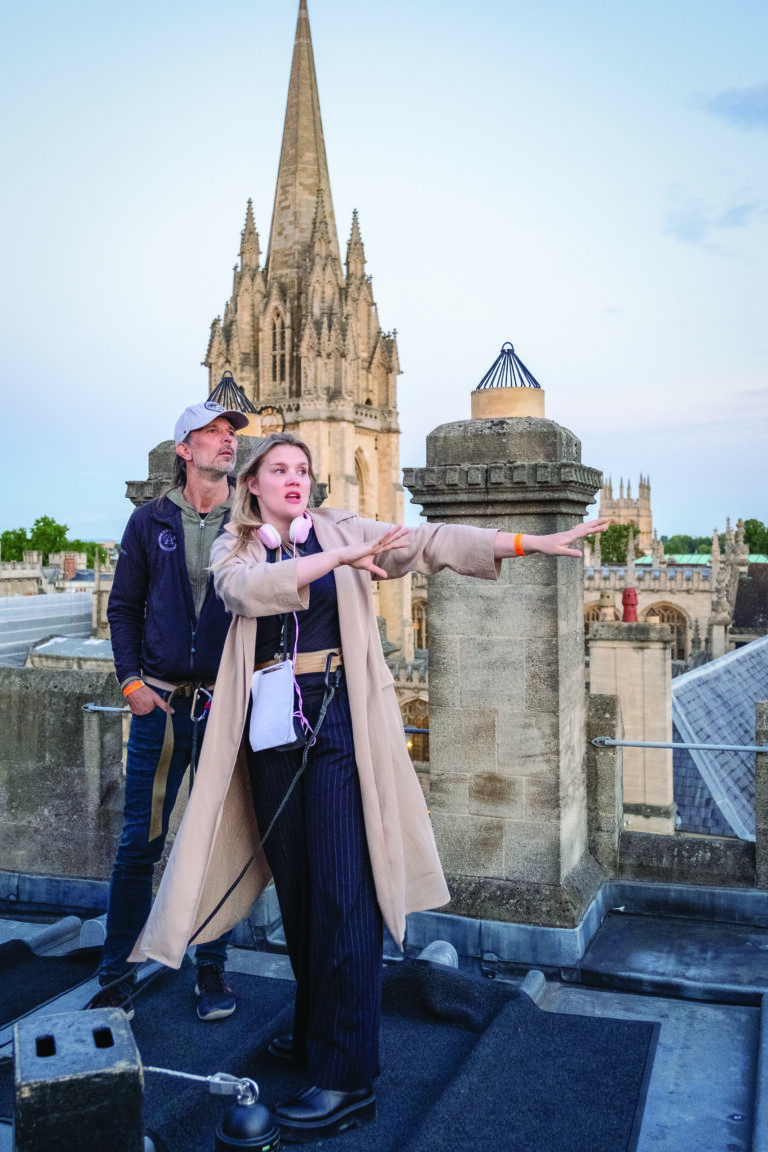
Attention to Saltburn
Oliver’s special power is his attention to detail, and it is Fennell’s, too. You can feel it from the opening titles of Saltburn. Fennell shot the entire film in a 1:33 ratio to achieve what she calls a “theatrical, handmade feel” — and she felt the titles should have the same “kind of human element.”
Graphic and titles designer Katie Buckley and her assistant, India Paparestis-Stacey, had already finished much of their work on the film when Fennell approached about creating the lettering that would help form the audience’s first impression of Saltburn.
Buckley amusedly recalls: “Emerald’s opening gambit to me was, ‘I really want the titles to feel like it’s the crazy woman in the attic, drawing, painting and scratching at the rafters. And I’d love you to do it, as I feel you are that person.’ Who could resist such a job description?
“We had created many family heirlooms and history throughout the film, like the Saltburn crest and family tree,” Buckley continues. “As we had such positive feedback from Emerald, I felt like I sensed what she wanted for the titles. Something that felt ancient and rooted and, as she exclaimed, something a bit Hammer House of Horror” — a reference to the British film company known for Gothic horror and fantasy films.
“There were many iterations before we got to the final font, and as soon as that one was put forward, she knew straight away that that was the Saltburn font,” Buckley adds. “We talked about adding sparkle to all the main artist’s names, which is why I ended up doing gold leaf on the names and animated thorns.”
Fennell loves littering immaculate sets with what she calls her “shit” — the little things, like misplaced toothbrushes and odd pool floats, that make a home feel lived in. Film is a “contained visual medium,” she says, so every bit of information a shot can convey is crucial.
“It’s fun creating the big sets and locations but it’s also very satisfying to hone in on the detail — the finetuning of these spaces helps describe our characters’ personalities, their backstories and their world,” says Saltburn set designer Suzie Davies. “So the kitsch inflatables of watermelons and flamingos could easily have seemed naff against the grandeur of Saltburn — but the Catton family had an effortless style and it worked — this set dressing felt opulent and extravagant.”

And in a film about desire, and sweat, and heat, the look of the characters’ bodies was vital. Cinematographer Sandren remembers talking with Fennell about “not just how to compose each shot, how we light it and what movement to use, but very much all details, like textures of skin, sweat, props — everything that helps convey the story.”
Alfred Hitchcock is among Fennell’s influences, and she shares his gift for knowing when to hold and cut.
“She’s working with the scenes like a great musician who masters the ‘tension and release’ to dramatize the melody,” says Sandgren. “She makes sure to load each shot with a lot of tension, and carefully decides when to release the shot for another. She pays a lot of attention to this, and since every shot is carefully thought of, she also confidently sticks to the shots we need, rather than working with safety coverage.”
Of course the film has an insatiable quality, and unslakable thirst.
“In my initial conversations with Emerald about the story and her intentions, themes like voyeurism, love and degradation, beauty, sexiness and ugliness were mentioned. But she also shared phrases like ‘infeasible desires,’ ‘loving to death,’ and ‘lick each other dry,’ and she pretty much described characters like vampires,” adds Sandgren.
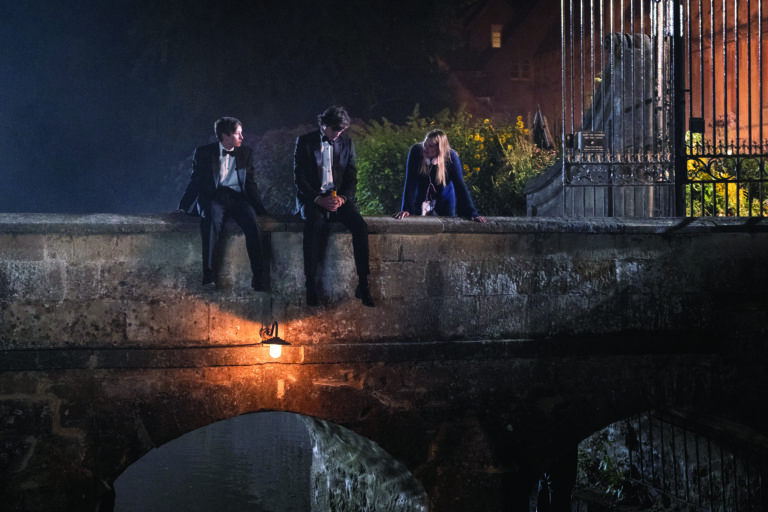
Love
Fennell is 37 now, a parent, and well-established in the world. But she chose to set Saltburn in the not-so-distant past because that’s the time when she remembers wanting the most.
“If we think of the movie as being more metaphorical and allegorical and all of these things, like when you think of falling in love for the first time, or you think of wanting to be a someone — that feeling when you’re 19 or 20 and you have an opportunity to have your life the way you want it, and to be with the people you want, and have the friends you want… It’s so specific, that feeling, that time of your life when you’re not jaded, and you are electric with desire.
“You are absolutely throbbing at all times. You can’t think because the stakes are so high. And that’s everyone, that’s every single person who’s ever been born. There’s a time in your life where you just think you can’t get enough of any of it. And that’s so dangerous. It’s dangerous.
“But it’s also when you’re most alive.”
Saltburn is now in theaters from MGM and Amazon Studios.
All Photos Courtesy of MGM and Amazon Studios.
Editor’s Note: This story was originally published in October and has been republished in honor of Saltburn’s theatrical release.
Share:

